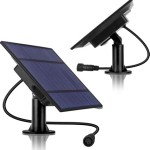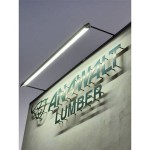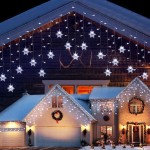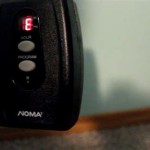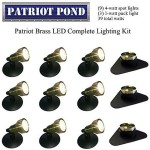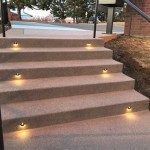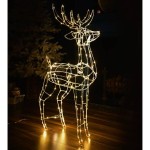How To Choose Outdoor LED Flood Lights
Outdoor LED flood lights are a versatile and efficient lighting solution for a variety of applications, ranging from security and safety to landscape enhancement and architectural accentuation. Selecting the right outdoor LED flood light requires careful consideration of several factors to ensure optimal performance, energy efficiency, and longevity. This article provides a comprehensive guide to help individuals and organizations make informed decisions when choosing outdoor LED flood lights.
Understanding Lumens and Wattage
A fundamental understanding of lumens and wattage is crucial for selecting the appropriate brightness level for outdoor LED flood lights. Lumens measure the total amount of visible light emitted by a light source. The higher the lumen output, the brighter the light. Historically, wattage was used as a proxy for brightness, but with the advent of energy-efficient LED technology, wattage now primarily indicates the power consumption of the light.
When choosing outdoor LED flood lights, focus on the lumen output to determine the brightness. Consider the area that needs to be illuminated and the desired level of brightness. For general security lighting, a lower lumen output might suffice, whereas for larger areas or tasks requiring high visibility, a higher lumen output is necessary. It is also important to understand that perceived brightness can be affected by factors such as the color temperature and the reflectivity of the surrounding surfaces.
Wattage, on the other hand, is an indicator of energy consumption. LED technology is significantly more energy-efficient than traditional lighting technologies such as incandescent or halogen. This means that an LED flood light can produce the same amount of light (lumens) as an incandescent or halogen bulb while consuming significantly less power (watts). Choosing LED flood lights with lower wattage ratings can lead to substantial energy savings over time. Examine the lumens-per-watt ratio to assess the energy efficiency of different LED flood lights. A higher lumens-per-watt ratio indicates greater energy efficiency.
It is also essential to consider the relationship between lumens and the beam angle of the flood light. A wider beam angle will spread the light over a larger area, resulting in lower light intensity at any given point. Conversely, a narrower beam angle will concentrate the light into a smaller area, resulting in higher light intensity. The choice of beam angle will depend on the specific application and the desired coverage area.
Evaluating Color Temperature and CRI
Color temperature and Color Rendering Index (CRI) are two important factors that influence the quality of light produced by outdoor LED flood lights. Color temperature is measured in Kelvin (K) and describes the perceived warmth or coolness of the light. Lower color temperatures (e.g., 2700K-3000K) produce a warm, yellowish light, whereas higher color temperatures (e.g., 5000K-6500K) produce a cool, bluish-white light.
The choice of color temperature depends on the specific application and the desired aesthetic effect. Warm white light is generally preferred for residential areas, as it creates a cozy and inviting atmosphere. Cool white light is often preferred for commercial or industrial areas, as it provides better visibility and alertness. Neutral white light (e.g., 4000K) is a good compromise between warm and cool light and can be suitable for a variety of applications.
CRI is a measure of how accurately a light source renders the colors of objects compared to a natural light source such as sunlight. CRI is measured on a scale of 0 to 100, with 100 representing perfect color rendering. A higher CRI indicates more accurate color rendering. For applications where accurate color rendition is important, such as landscape lighting or architectural accentuation, choose outdoor LED flood lights with a CRI of 80 or higher.
For security lighting, the color temperature is less critical than the brightness and coverage area. However, a cool white or neutral white light can provide better visibility and contrast, which can be helpful for identifying potential threats. The CRI may be less important for security lighting, as the primary objective is to illuminate the area rather than to accurately render colors.
Consider the surrounding environment when selecting the color temperature. If the area is surrounded by warm-toned materials, such as brick or wood, a warm white light can complement the existing aesthetic. If the area is surrounded by cool-toned materials, such as concrete or metal, a cool white light can be a better choice.
Assessing Durability and Weather Resistance
Outdoor LED flood lights are exposed to a variety of environmental conditions, including rain, snow, heat, cold, and dust. It is essential to choose flood lights that are durable and weather-resistant to ensure reliable performance and longevity. Two key factors to consider are the Ingress Protection (IP) rating and the materials used in the construction of the flood light.
The IP rating is a standardized system that classifies the degree of protection provided by an enclosure against the ingress of solid objects (e.g., dust, dirt) and liquids (e.g., water). The IP rating consists of two digits. The first digit indicates the level of protection against solid objects, and the second digit indicates the level of protection against liquids. For outdoor applications, choose LED flood lights with an IP rating of at least IP65, which provides protection against dust and water jets. For areas that are exposed to heavy rain or submersion, choose flood lights with an IP rating of IP67 or IP68.
The materials used in the construction of the flood light also play a significant role in its durability and weather resistance. Look for flood lights made from corrosion-resistant materials such as die-cast aluminum or stainless steel. These materials can withstand harsh environmental conditions without corroding or deteriorating. The lens of the flood light should be made from tempered glass or polycarbonate, which are both durable and resistant to breakage.
Consider the operating temperature range of the flood light. Ensure that the flood light is designed to operate within the temperature range of the local climate. Some LED flood lights are designed to operate in extreme temperatures, while others are more suitable for moderate climates. Selecting a flood light with an appropriate operating temperature range can prevent premature failure and ensure reliable performance.
Examine the warranty offered by the manufacturer. A longer warranty period indicates that the manufacturer has confidence in the quality and durability of the product. Read the warranty terms and conditions carefully to understand what is covered and what is not. Choose a reputable manufacturer with a proven track record of producing high-quality outdoor LED flood lights.
Evaluating Control Options and Features
Outdoor LED flood lights are available with a variety of control options and features that can enhance their functionality and convenience. These options include dimming capabilities, motion sensors, photocells, and smart controls. Consider the specific needs and preferences when choosing the appropriate control options and features.
Dimming capabilities allow adjusting the brightness of the flood light to suit different situations. Dimming can save energy and reduce light pollution when full brightness is not required. Some LED flood lights are compatible with standard dimmers, while others require specialized LED dimmers. Ensure that the dimmer is compatible with the flood light before purchasing it.
Motion sensors can automatically turn on the flood light when motion is detected, providing security and convenience. Motion-activated flood lights can deter intruders and illuminate pathways for nighttime navigation. The sensitivity and range of the motion sensor can be adjusted to prevent false alarms. Consider the placement of the flood light when selecting a motion sensor, as obstructions can interfere with its performance.
Photocells can automatically turn on the flood light at dusk and turn it off at dawn, providing automated lighting control. Photocells can save energy and eliminate the need to manually switch the flood light on and off. The sensitivity of the photocell can be adjusted to compensate for variations in ambient light levels. Consider the location of the photocell when installing the flood light, as shadows or artificial light sources can affect its performance.
Smart controls allow controlling the flood light remotely using a smartphone or tablet. Smart flood lights can be integrated into a smart home system, allowing centralized control and automation of lighting. Smart controls can offer a variety of features, such as scheduling, dimming, and color temperature adjustment. Consider the compatibility of the smart flood light with the existing smart home system before purchasing it.

Led Flood Lights What You Need To Know

Led Flood Lights What You Need To Know

How To Choose Outdoor Led Flood Lights For Your Landscape Mic

How To Choose The Right Outdoor Led Flood Light

How To Choose A Good Outdoor Led Flood Light Blog Yaham Lighting

Luxrite 15 30 50 Watt Up To 6500 Lumen Integrated Led Flood Lights Outdoor Dusk Dawn Sensor 3cct 3000k 5000k Brown 2 Pack Lr40350 2pk The Home Depot

The Ultimate Guide To Choosing Right Outdoor Led Flood Lights

12 Tips To Select The Best Outdoor Led Flood Lights And Manufacturers

How To Choose The Best Led Outdoor Flood Lights

Led Flood Light Choose The Ideal Outdoor Lighting Fixture Ledmyplace

